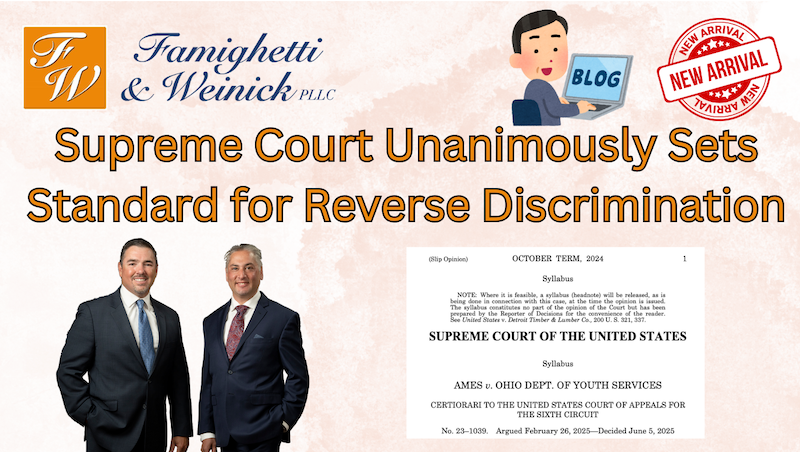- Free Consultation: (631) 352-0050 Tap Here to Call Us
Supreme Court Unanimously Sets Standard for “Reverse Discrimination” Claims

Title VII of the Civil Rights Act of 1964 prohibits employers from discriminating against employees on the basis of race, color, religion, national origin, or sex. So-called “reverse discrimination” claims arise when a member of a majority group is discriminated against, i.e. if a white male were to face employment discrimination on the basis of his race and/or sex. In such cases, federal appellate courts were split about how to analyze the claims. Some used the same analysis as in traditional discrimination claims, but others used a “background circumstances” test. On June 5, 2025, the Supreme Court unanimously settled the question. Today’s employment law blog looks at the Ames v. Ohio Department of Youth Services decision.
The Facts of the Ames Case
The plaintiff in the Ames case is Marlean Ames. She is a heterosexual woman who worked for the defendant-employer, Ohio Department of Youth Services. Ames started work in 2004 as an executive secretary and was eventually promoted to the program administrator.
In 2019, Ames applied for a new management position. The department interviewed her, but ultimately hired a lesbian woman for the job. Further, a few days after she interviewed for the job, the department demoted her causing a significant cut in pay. The department hired a gay man to replace her as program administrator. Ames then filed a lawsuit under Title VII alleging she was discriminated on the basis of her sexual orientation.
The Lower Courts Applied a Background Circumstances Analysis to Dismiss Ames’s Case
At the trial court, the employer moved for summary judgment asking that the case be dismissed. The court applied a “background circumstances” test. The test requires the employee to present evidence suggesting that the employer was the rare employer who discriminates against members of a majority group. The court determined that Ames failed to establish this evidence and it dismissed the case.
Ames appealed to the Sixth Circuit Court of Appeals. But, the court agreed that the trial court correctly dismissed the case. The Sixth Circuit ruled that since Ames is a straight woman, she was required to meet a heightened burden. The Sixth Circuit discussed the background circumstances standard as requiring evidence that the employment decision was made by a minority group or statistical evidence which would support a pattern of discrimination. Since Ames presented neither, the employer was entitled to have the case dismissed.
The Supreme Court Unanimously Rejects the Background Circumstances Standard
After the Sixth Circuit, Ames appealed to the United States Supreme Court. The Supreme Court, in a unanimous decision, rejected the background circumstances standard used by the Sixth, Seventh, Eighth, Tenth, and D.C. Circuits. To reach its decision, the Supreme Court referred back to the framework used to analyze all discrimination claims. Known as the McDonnell Douglas burden shifting test, the first part of the test requires the plaintiff to pass an initial burden of establishing a prima facie case of discrimination. If established, then the employer must articulate a non-discriminatory reason for the employment decision. Then, the burden shifts back to the employee to show that the business is reason is pre-text for discrimination.
The Supreme Court determined that the Sixth Circuit’s approach imposed an additional burden on the plaintiff, requiring proof of the background circumstances. The Supreme Court ruled that this burden is not correct based on the text of Title VII and cases interpreting Title VII.
For starters the Court noted that Title VII’s text makes no distinction between majority groups and minority groups. Rather, the statute prohibits discrimination against “any” individual.
Further, the Court’s history of interpreting Title VII does not support the background circumstances approach. In 1971, the Court ruled explicitly that Title VII protects minority and majority groups. Similarly, in 1976, the Court outright rejected the notion that Title VII’s protection do not extend to white employees, i.e. a majority group.
The Court summarized its history of Title VII by noting that it had never indicated that the standard for proving discrimination should vary based on whether the plaintiff is in a majority or minority group. Justice Jackson, writing for the Court, ruled that the background circumstances standard, flouts this interpretation, so it is wrong.
Implications for Future Cases
The Ames decision is a win for employees. It confirms that so-called reverse discrimination claims are viable. More importantly, the decision rejects the heightened standard imposed by some jurisdictions to prove such claims. Reverse discrimination claims can be proven using the same framework which has long been applied to all discrimination claims.
If you have questions about the Ames decision, reverse discrimination, or any other kind of discrimination, contact one of our employment discrimination lawyers at Famighetti & Weinick PLLC. Our phone number (631) 352-0050.










